
Vol. IX, No. 7, August 2009
- Editor's corner
- Social media pays
- The future of leisure time; a new value equation
- The iconic hamburger/cheeseburger goes premium
- Business death spiral!
- Foundations Entertainment University, Oct. 6-8, Dallas, Texas
- BellaBoo's opens Sept. 15
- Vicki Stoecklin featured in two magazines
- Put your business correctly on the map
- 100 flavors in new Coca-Cola soda machine
- How Americans spent their time in 2008
- Chuck E. Cheese's reports 2nd quarter results
- New clients
Editor's corner
 So much to write about and so little time. That’s a constant problem with our Leisure eNewsletter. We try to give coverage to timely and interesting topics that relate to location-based leisure in all its many forms, whether the venue is entertainment, edutainment, eatertainment, play, dining, shopping, informal learning venue, or all the other variations and hybrids. The problem? Each month we have far more material than we have time to write about, or you, our reader, have time to read. That is one of the reasons we started tweeting on Twitter. We see a lot that may interest you, but we just can’t cover it all in this eNewsletter. So we periodically send out tweets with URL links to the materials. You don’t have to be signed up to Twitter to follow us, although that has advantages, especially if you like RSS feeds. You can find our tweets at http://twitter.com/whitehutchinson.
So much to write about and so little time. That’s a constant problem with our Leisure eNewsletter. We try to give coverage to timely and interesting topics that relate to location-based leisure in all its many forms, whether the venue is entertainment, edutainment, eatertainment, play, dining, shopping, informal learning venue, or all the other variations and hybrids. The problem? Each month we have far more material than we have time to write about, or you, our reader, have time to read. That is one of the reasons we started tweeting on Twitter. We see a lot that may interest you, but we just can’t cover it all in this eNewsletter. So we periodically send out tweets with URL links to the materials. You don’t have to be signed up to Twitter to follow us, although that has advantages, especially if you like RSS feeds. You can find our tweets at http://twitter.com/whitehutchinson.
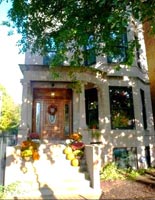 Here’s a useful hint if you like to print out a hard copy of our eNewsletter for later reading. The version posted on our website is set up so you can print one story at a time.
Here’s a useful hint if you like to print out a hard copy of our eNewsletter for later reading. The version posted on our website is set up so you can print one story at a time.
Many of our readers have given us positive feedback about my travelogues. So this month, I am taking you to Hyde Park, Chicago, Illinois. We recently stayed in Hyde Park at the University Quarters Bed & Breakfast & Suites over the weekend before driving down to Indiana to BellaBoo’s, one of our projects opening in September. (see story below).
Hyde Park is a Chicago neighborhood located along Lake Michigan, about seven miles south of the Chicago Loop, the heart of downtown Chicago. Hyde Park was founded in the 1850s and became a township in 1861. In the early 1890s, the University of Chicago was founded in Hyde Park by John D. Rockefeller. The campus is bisected by the Midway Plaisance, a large linear park created for the 1893 World’s Fair. The bulk of the campus is located north of the Midway. Current enrollment is about 5,000 undergraduates and 9,000 graduate, professional and other students.
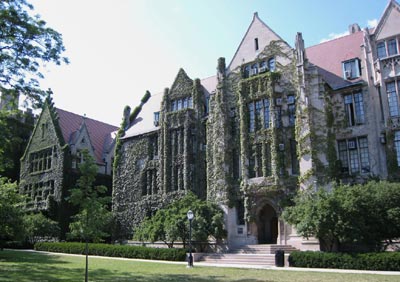
Parts of the University of Chicago could be mistaken
for the Hogwarts School of Witchcraft and Wizardry.
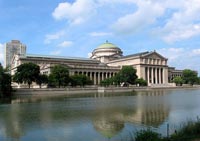 When you visit the older buildings around the quadrangle at the University of Chicago, you have to wonder if it couldn’t also be the real life version or at least the inspiration for the fictitious Hogwarts School of Witchcraft and Wizardry where most of the Harry Potter series (books and films) takes place.
When you visit the older buildings around the quadrangle at the University of Chicago, you have to wonder if it couldn’t also be the real life version or at least the inspiration for the fictitious Hogwarts School of Witchcraft and Wizardry where most of the Harry Potter series (books and films) takes place.
In 1893, Hyde Park hosted the World’s Columbian Exposition (World’s Fair). While the fair covered 600 acres, the only structure left today is the Palace for Fine Arts, which has since been converted into Chicago’s Museum of Science and Industry. Unlike the fair’s 200 temporary buildings, that building was built with a brick and block structure to be fireproof, because it housed many of the world’s art treasures. During its six-month run, 27 million people attended the exposition.
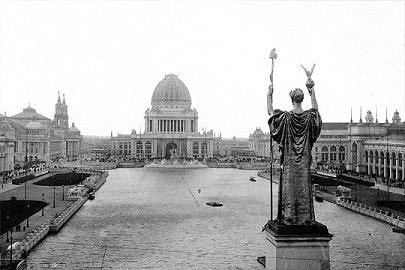
1893 World’s Fair was held in Hyde Park, Illinois.
There’s a very good read historical novel, The Devil in the White City, that tells the stories of two men: Daniel H. Burnham, the architect responsible for the 1893 World’s Fair construction, and H.H. Holmes, a serial killer masquerading as a charming doctor, who is believed to be responsible for scores of murders around the time of the fair. (P.S. The 1893 World’s Fair was known as the White City because all the buildings were white.)
While in Hyde Park, we visited the Robie House, designed by Frank Lloyd Wright in 1908, completed in 1910 and considered one of the most important buildings in the history of American architecture. The Robie House is renowned as the greatest example of Wright’s Prairie School style. Prairie homes utilized low lying horizontal lines that echo the wide, flat, tree-less expanses of the mid-Western United States and featured open floor plans.
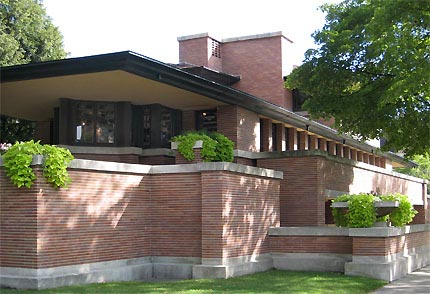
Robie House, designed by Frank Lloyd Wright
Wright was way ahead of his time with his designs. Modern architects and interior designers could learn a lot about great design not only by studying, but also by visiting some Wright buildings such as the Robie House. You really can’t appreciate the emotional qualities of Wright’s designs and spaces without experiencing them.
Wright believed every building should grow naturally from its environment. He practiced what is known as organic architecture, an architecture that evolves naturally out of the context, and most importantly for him, the relationship between the site and the building and the needs of the client. For example, houses in wooded regions made heavy use of wood, desert houses had rambling floor plans and heavy use of stone, and houses in rocky areas such as Los Angeles were built mainly of cinder block.
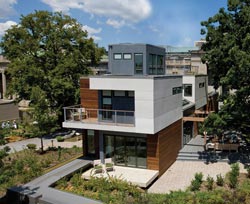 Qualities of Wright’s mastery of design you learn to appreciate when visiting the Robie House include its human scale, natural light, blend with nature, attention to detail and just the livability and pleasure of being in the many rooms and spaces.
Qualities of Wright’s mastery of design you learn to appreciate when visiting the Robie House include its human scale, natural light, blend with nature, attention to detail and just the livability and pleasure of being in the many rooms and spaces.
In contrast to Wright’s almost century-old house, while still in Hyde Park we visited the Chicago Museum of Science and Industry and its Smart Home there, a three-story modular and sustainable green home that features the latest 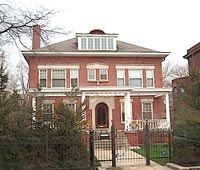 innovations in reusable resources; smart energy consumption; clean, healthy-living environments and easy ways to go green.
innovations in reusable resources; smart energy consumption; clean, healthy-living environments and easy ways to go green.
Hyde Park and its adjoining neighborhood of Kenwood have also become famous for the three-story, 6,500-square-foot Georgian-style home of U.S. President Barack Obama’s house (not the White House, the U.S. government owns it). Chicago police and Secret Service now heavily guard the street where the house is located.
We have lots of interesting articles in this edition. We hope you enjoy them and find them of value.
Randy White
Editor
Vol. IX, No. 7, August 2009
- Editor's corner
- Social media pays
- The future of leisure time; a new value equation
- The iconic hamburger/cheeseburger goes premium
- Business death spiral!
- Foundations Entertainment University, Oct. 6-8, Dallas, Texas
- BellaBoo's opens Sept. 15
- Vicki Stoecklin featured in two magazines
- Put your business correctly on the map
- 100 flavors in new Coca-Cola soda machine
- How Americans spent their time in 2008
- Chuck E. Cheese's reports 2nd quarter results
- New clients



